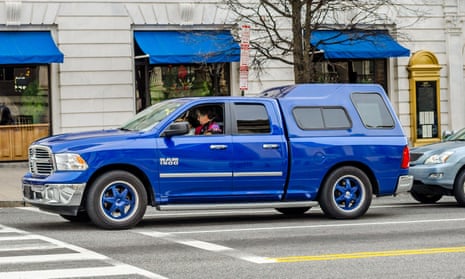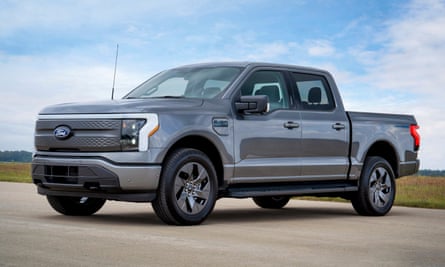
Monster pickup trucks accelerate into Europe as sales rise despite safety fears
A Dodge Ram 1500 is bigger than a Panzer I tank and campaigners say heavy trucks are ‘lethal’ in collisions
The engines rev, the guitars thrum and a gruff narrator lays out why the vehicle occupying the driveway is more than just a machine. “A truck is a tool,” he says, “but a Ram – a Ram is life.”
So begins an advert for the Ram 1500, a pickup truck slightly bigger than the Panzer I tanks of Nazi Germany and almost as heavy. It is growing in popularity in Europe, with the number of Rams arriving on the continent up 20% in 2023 from the year before, according to registration data from the European Environment Agency. Road safety and environmental campaigners in the UK and Europe are aghast as the latest, most extreme cases of North American car bloat – giant pickup trucks – are increasingly crossing the Atlantic.
“Europe should ban the Ram,” said Dudley Curtis from the European Transport Safety Council. “This type of vehicle is excessively heavy, tall and powerful, making it lethal in collisions with normal-sized vehicles, pedestrians and cyclists.”
For now, the giant vehicles fall foul of EU environmental rules but can be imported through a back-door channel known as an individual vehicle approval (IVA) that subjects them to less scrutiny. Nearly 5,000 Dodge Rams were brought to Europe last year, and about 60% of IVA approvals in the EU, Norway and Iceland are for the Ram – whose manufacturer, Stellantis, did not respond to requests for comment. Other large pickup trucks, such as the Ford F-150 and Chevrolet Silverado, are also arriving but in smaller numbers. On Tuesday, the Guardian revealed that one of Europe’s first Tesla Cybertrucks may have been registered incorrectly through the same route.

It is the latest development in the global story of car bloat. Sales of SUVs have been soaring for several years as carmakers have marketed larger cars and consumers have chosen to pay premiums to snap them up. The weighty vehicles, vaunted for off-road abilities that let them conquer rugged terrain, have become common sights on the smooth tarmac of supermarket car parks and the concrete pavements outside school gates.
“People wear their large SUV like an expensive coat,” said Robin Hickman, a transport planner at University College London. “It’s an aspiration for a certain type of lifestyle that people subscribe to.” Increasingly, however, pickup trucks are being marketed as versatile vehicles that urban dwellers can use to meet their daily needs.
Brutal physics reveals a dark side to the big-car boom. At its simplest, a vehicle with more mass will hit a person with more force. But a higher bonnet also makes it harder for the driver to see a child and more likely that their vehicle will strike its head, or an adult’s vital organs. Unlike the victims of regular car crashes, who are often pushed to the side or on to the windscreen, people struck by pickup trucks tend to be pushed forward and mown down.
Researchers have seen such mechanisms play out in crash data. In August, the Vias institute in Belgium found a pedestrian or cyclist hit by a pickup was 90% more likely to face serious injury than one hit by a regular car, and almost 200% more likely to be killed.
after newsletter promotion
In November last year, the Insurance Institute for Highway Safety in the US found the risk of death was about 45% greater if a pedestrian were hit by a vehicle with a tall bonnet than one that was low and sloped. In January, a US study found a 10cm increase in bonnet height causes a 22% increase in fatality risk for pedestrians. The increase in risk rose to 31% for over-65s, and to 81% for children.
But few people seem aware of the dangers. Just 40% of British adults agree that SUVs and pickup trucks are dangerous to other people, a YouGov survey found in February, falling to 20% for owners of such vehicles.
Some people justify buying big vehicles because they offer families more comfort. Others say they feel safer in larger cars – even if that security comes at the expense of others.
“People buying the SUVs are either very selfish and do not care about anyone else on the street, or, more likely, they just do not think of those issues,” said Hickman. “It may [one day] be their children walking out of the football pitch or the cricket pitch who get run over by an SUV, and then they would be horrified.”
Researchers suggest the mix of aggressive advertising, status-seeking and poor public awareness make it easy for carmakers to push ever bigger vehicles. A study of UK residents from the campaign group Badvertising in 2021 found a positive correlation between exposure to SUV advertising and the desire to buy one.
Mònica Guillen-Royo, a co-author of the report, said: “The industry’s efforts to expand sales of bigger cars are likely to succeed, due to their alignment with people’s everyday lives, which are shaped by car dependency. On the other hand, society’s efforts to reduce emissions from cars will not be supported by messaging alone.”
European cities such as Paris, Lyon, Grenoble and Tübingen have imposed weight-based fees that make SUV and pickup truck drivers pay more to park. Campaigners have called on the European Commission to tighten safety rules and close the approval loophole that lets big pickups sneak on to European roads.
“It’s the old story of a chain only being as strong as its weakest link,” said James Nix, from the campaign group Transport & Environment. “The EU and UK have built a legal framework to safeguard the public from high levels of air pollution, climate emissions and road safety risks from vehicles. But then, when importers of mass market pickup trucks get them approved as ‘individual’ vehicles, they avoid Europe’s carefully constructed safeguards.”
However, despite the explosive growth, large pickup trucks still only made up less than 1% of new car and van registrations in Europe in 2023. The vehicles are far more polluting than regular cars, but those approved via the IVA loophole do not count toward the EU’s fleet-wide CO2 targets of 94g/km for cars and 154g/km for vans from 2025.
To meet the targets and compensate the emissions from each large pickup truck, a manufacturer would, in theory, have to put three extra electric vehicles on the road, said Peter Mock, the managing director of the European branch of the International Council on Clean Transportation. “Instead of complaining about regulation, automakers would be better off reconsidering their marketing shift to ever bigger SUVs and pickup trucks.”